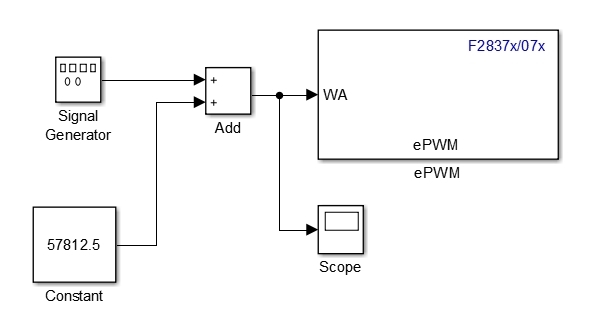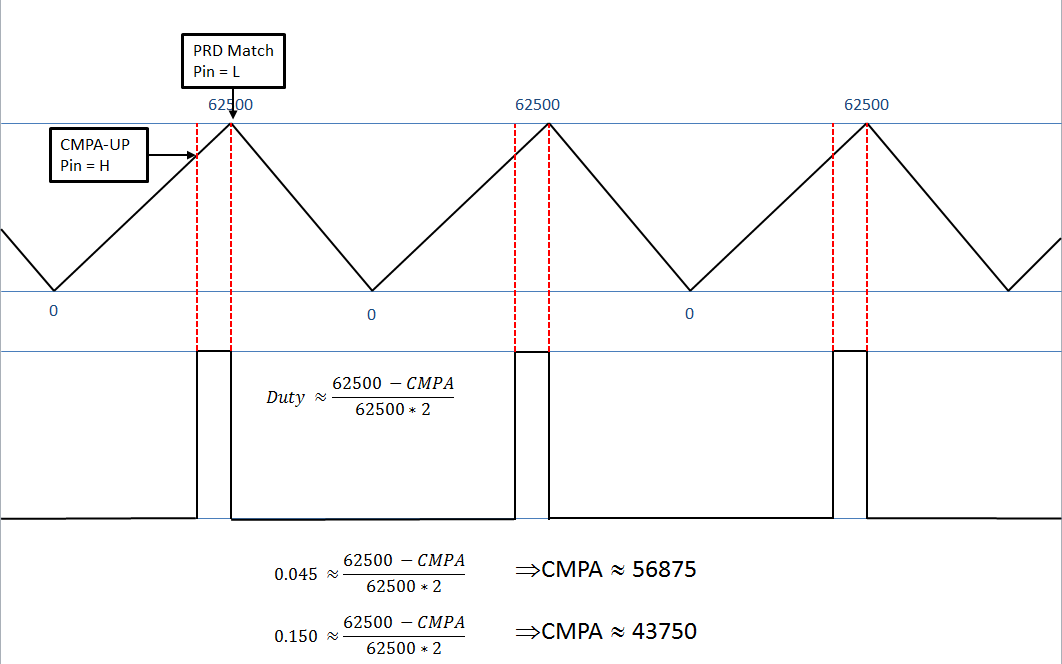Hi all,
Information about what I am trying to do:
I am trying to sweep the shaft of my servo motor (Hitec HS-422) back and forth across 180 degrees. I am using Simulink (and Embedded Coder) to program my TI's TMS320F28379D LaunchPad XL.
Figure 1 (below) shows my Simulink model.
Let's begin with verifying my calculations.
TBCLK = PWM Clock / (HSPCLKDIV * CLKDIV)
PWM Clock = SYSCLKOUT * EPWMCLKDIV, where CPU Clock (SYSCLKOUT) = 200 MHz.
By default EPWMCLKDIV = 1/2
Then PWM Clock = 100 MHz and hence,
TBCLK = 100 MHz / (HSPCLKDIV * CLKDIV) (Eq 1)
The "counting mode" is configured to be Up-Down, then
TBPRD = (1/2) * (f_TBCLK / f_PWM) (Eq 2)
Substituting Eq 1 into Eq 2,
TBPRD = (1/2) * 100 MHz / (f_PWM * HSPCLKDIV * CLKDIV) (Eq 3)
According to the datasheet of my servo motor the f_PWM of the motor is 50 Hz.
Now, we need to choose HSPCLKDIV and CLKDIV such that TBPRD <= 2^16.
Let HSPCLKDIV = 2, and CLKDIV = 8, then TBPRD = 62500.
Again, in the datasheet the pulse duration is given as "from 0.9 ms to 2.1 ms" and T_PWM = 20 ms (or 50 Hz).
So what is the range of duty cycle? It is from 4.5% to 10.5%. (This seems too low.)
Now we can calculate CMPA Clock Cycles.
For 4.5% duty cycle,
CPMA = (100% - 4.5%) * TBPRD = (95.5/100) * 62500 = 59687.5
For 10.5% duty cycle,
CMPA = (100% - 10.5%) * TMPRD = (89.5/100) * 62500 = 55937.5
Then the WA signal (Specifies CMPA via the input port) should be:
Amplitude: (59687.5 - 55937.5) / 2 = 1875, Offset: 1875 + 55937.5 = 57812.5, Frequency: 1 Hz (Arbitrary), Type: Square
Result: This didn't work as I expected. The motor vibrates with a buzz sound and doesn't move.
Then (based on my experience) I changed CMPA Units from "Clock cycle" to "Percentage" and applied a sinusoidal signal with the following features:
Amplitude: 15, Offset: 15, Frequency: 1 Hz (Arbitrary), Type: Sine
Result: It does sweep but this was just an educated guess. Please see the video below and notice that there is a tiny amount of buzz noise.
Can you explain what am I doing wrong with my calculations? I have a meeting with my supervisor tomorrow I need to get this working before then. Thanks!





